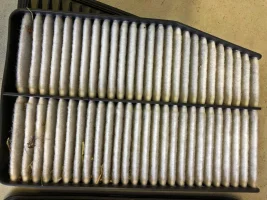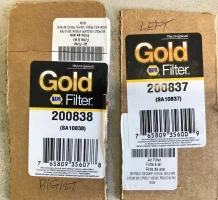Jay Tea
Newish Member


Greetings GT Fans!
I searched high & low across the internet (including this forum), for torque specifications for reinstalling the radiator braces which cover the filter boxes (what many mistakenly refer to as suspension tower braces), and found nothing. So, I thought I'd post my experience here.
Using "reverse engineering" (removing the braces by dialing-up my torque wrench 1 foot-pound at a time until the nuts started to loosen), then averaging the torque among all four bolts, it appears that the OE torque is in the 24-26 foot-pound range.
General thoughts -
a) WIX makes the best air filters (SA 10837 and 10838), and markets them for NAPA as "Gold" (200837 and 200838), for just under $20 each. These new replacement filters appear to be a slightly better / thicker fabric than OE.
b) When I installed these at ~12,000 miles, the original OE filters were VERY dirty (by comparison, the new filters are pure white). In the future, I will replace at ~10,000 miles, as higher-boost turbocharged engines suck a tremendous amount of air, requiring more frequent filter changes than in naturally-aspirated engines.
c) When replacing filters, I treat the filter area like a 'clean room', vacuuming all external and internal housing areas, then wipe the inlet filter housing-to-turbo hose with a damp white cotton glove before re-assembly.
d) Re-torque hose clamps ~30 inch-pounds (NOT foot-pounds!).
For those K&N lovers, not to be argumentative, my experience has been that the best-quality fabric-type air filters (like WIX) do a better job at removing extreme fines. I have used both in my naturally aspirated (non-turbo) track car, and when wiping the inside of the air inlet hose (after the filter housing) I see much more dirt on a white cotton glove using K&N than WIX. K&N's big advantage is that it flows more air, yielding more HP in a NA engine. This advantage is probably less in a street twin-turbo engine?
Finally, don't forget to document your maintenance by photocopying / scanning the purchase receipt and the box part number, then recording the date and mileage in your maintenance log (do this for oil changes and any other maintenance you perform as well).
Happy & safe shredding!






